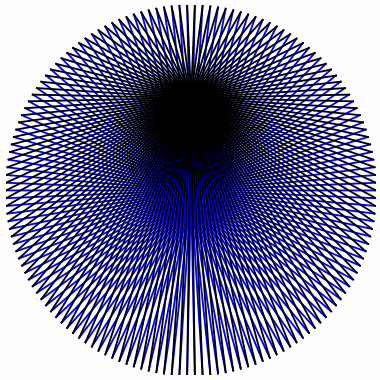A Moiré pattern formed with 2 sets of rays.
Code for Mathematica:Manipulate[
Graphics[
{Thickness[.005],
{Blue, {Line[
Table[{{Cos[t], Sin[t]}, {0, 0}}, {t, 2. Pi/150, 2. Pi, 2. Pi/150}]]}},
{Line[Table[{{Cos[t], Sin[t]}, {0, s}}, {t, 2. Pi/150, 2. Pi, 2. Pi/150}]]}},
PlotRange -> 1],
{s, .5, -.5, .1}]
reblogged archiveofaffinities
Stanley Tigerman
The Formal Generators of Structure,
Drawings by Gordon Crabtree,
1965-1968
Nobel Prize in Chemistry for dogged work on 'impossible' quasicrystals →
Henrique Oliveira is a Brazilian artist known for working with salvaged wood which he peels and used to create these incredible installations. The texture of the wood is reminiscent of the strokes of a paint brush or the folds of human fat, giving some eerie, living feeling to his installations, as if they should start breathing. Like a mass of tree roots or a spinal cords, his pieces seem to support the gallery walls, their parasitic growth holding them up, like a tumour, gluing together but also invading the space. Their luscious organic colours bring to mind skin, flesh, rolls of the stomach. Each piece is site specific, the artist responds directly to the architecture of each gallery they are installed in.
Click through on the image for a link to his website.
dvdp:
110913
reblogged responsivesarchitectures:
3D Printed Hovering Ornithopters
This project currently focuses on developing a flapping-wing hovering insect using 3D printed wings and mechanical parts. The use of 3D printing technology has greatly expanded the possibilities for wing design, allowing wing shapes to replicate those of real insects or virtually any other shape. It has also reduced the time of a wing design cycle to a matter of minutes. An ornithopter with a mass of 3.89g has been constructed using the 3D printing technique and has demonstrated an 85-second passively stable untethered hovering flight. This flight exhibits the functional utility of printed materials for flapping wing experimentation and ornithopter construction and for understanding the mechanical principles underlying insect flight and control.
by Charlie Richter, Floris van Breugel, William Regan, Zhi Ern Teoh
Take a look at the physics of a pint of Guinness, including the formation of foam, the circulation of bubbles, and the importance of nitrogen and surfactants. The Physics of Fluids paper the host refers to is available here. (And, yes, I will admit to debating the physics occurring in my pint glass while in a pub.) # (via Martin)
Man O War by Morphologic
SPOILER: nothing happens, this is just a beautiful subtly moving image.
Here astronaut Don Pettit demonstrates the effects of rotation on a sphere of water in microgravity. Bubbles, being less dense than water, congregate in the middle of the sphere along its axis of rotation. Tea leaves, which are denser than the water, are thrown to the outside; this is the same concept used in a centrifuge for separating samples.
Win a sculpture TODAY!!!!! (just a tenner!)….and help send me off to do my Masters!
See more work at www.alexandracarr.co.uk
Sculpture at Knockan Crag (by swan-scot)

















